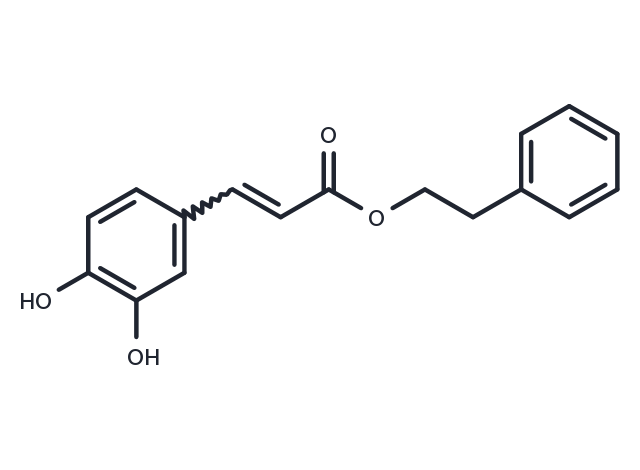Powder: -20°C for 3 years | In solvent: -80°C for 1 year
Caffeic Acid Phenethyl Ester (Phenylethyl Caffeate) (CAPE) inhibits the activation of nuclear transcription factor NF-kappa B and may suppress p70S6K and Akt-driven signaling pathways, with antineoplastic, cytoprotective and immunomodulating activities. CAPE is the phenethyl alcohol ester of caffeic acid and a bioactive component of honeybee hive propolis. In addition, CAPE inhibits PDGF-induced proliferation of vascular smooth muscle cells through the activation of p38 mitogen-activated protein kinase (MAPK) and hypoxia-inducible factor (HIF)-1alpha and subsequent induction of heme oxygenase-1 (HO-1).

| パッケージサイズ | 在庫状況 | 単価(税別) | |||
|---|---|---|---|---|---|
| サンプルについてお問い合わせ | |||||
| 10 mg | 在庫あり | ¥ 7,500 | |||
| 25 mg | 在庫あり | ¥ 11,500 | |||
| 50 mg | 在庫あり | ¥ 14,000 | |||
| 100 mg | 在庫あり | ¥ 17,000 | |||
| 200 mg | 在庫あり | ¥ 24,500 | |||
| 500 mg | 在庫あり | ¥ 40,000 | |||
| 1 mL * 10 mM (in DMSO) | 在庫あり | ¥ 9,000 | |||
| 説明 | Caffeic Acid Phenethyl Ester (Phenylethyl Caffeate) (CAPE) inhibits the activation of nuclear transcription factor NF-kappa B and may suppress p70S6K and Akt-driven signaling pathways, with antineoplastic, cytoprotective and immunomodulating activities. CAPE is the phenethyl alcohol ester of caffeic acid and a bioactive component of honeybee hive propolis. In addition, CAPE inhibits PDGF-induced proliferation of vascular smooth muscle cells through the activation of p38 mitogen-activated protein kinase (MAPK) and hypoxia-inducible factor (HIF)-1alpha and subsequent induction of heme oxygenase-1 (HO-1). |
| In vitro | Caffeic acid phenethyl ester blocks NF-κB activation induced by phorbol ester, ceramide, okadaic acid, and hydrogen peroxide by preventing the translocation of the p65 subunit of NF-κB to the nucleus. [1] In a series of tumor cell lines, Caffeic acid phenethyl ester shows promising antiproliferative activity with EC50 of 1.76, 3.16, 13.7, and 44.0 μM against murine colon 26-L5, murine B16-BL6 melanoma, human HT-1080 fibrosarcoma and human lung A549 adenocarcinoma cell lines, respectively. [2] Caffeic acid phenethyl ester, as a potent antioxidant, exerts its anti-apoptotic effect in cerebellar granule cells by blocking ROS formation and inhibiting caspase activity. [3] Moreover, Caffeic acid phenethyl ester attenuates the pro-inflammatory phenotype of LPS-stimulated HSCs, and LPS-induced sensitization of HSCs to fibrogenic cytokines by inhibiting NF-κB signaling. [4] |
| In vivo | In vivo, Caffeic acid phenethyl ester (10 mg/kg, i.p.) inhibits the growth and angiogenesis of primary tumors in C57BL/6 and BALB/c mice inoculated with Lewis lung carcinoma, colon carcinoma, and melanoma cells. [5] Caffeic acid phenethyl ester (5, 10, 20 mg/kg) also shows immunomodulatory effects in vivo by decreasing thymus weight and/or cellularity of thymus and spleen. [6] |
| 細胞研究 | Human HT-1080 fibrosarcoma, human lung A549 adenocarcinoma and murine B16-BL6 melanoma cell lines are maintained in EMEM medium supplemented with 10% FCS, 0.1% sodium bicarbonate and 2 mM glutamine. Murine colon 26-L5 carcinoma cell line, on the other hand, is maintained in RPMI medium containing the same supplements as in EMEM. These are all highly metastatic cell lines except for A-549 carcinoma. Cellular viability is determined using the standard MTT assay. In brief, exponentially growing cells are harvested and 100 μl of cell suspension containing 2000 cells is plated in 96-well microtiter plates. After 24 h of incubation to allow for cell attachment, the cells are treated with varying concentrations of test samples in medium (100 μl) and incubated for 72 h at 37°C under 5% CO2. Three hours after the addition of MTT, the amount of formazan formed is measured spectrophotometrically at 550 nm with a Perkin Elmer HTS-7000 plate reader. The test samples are first dissolved in DMSO and then diluted with medium; the final concentration of DMSO is less than 0.25%. Normal also had the same extent of DMSO. 5-Fluorouracil (5-FU) and doxorubicin HCl are used as positive controls, and EC50 values are calculated from the mean values of data from 4 wells. (Only for Reference) |
| 植物由来 |
| 別名 | Phenylethyl Caffeate, CAPE |
| 分子量 | 284.31 |
| 分子式 | C17H16O4 |
| CAS No. | 104594-70-9 |
Powder: -20°C for 3 years | In solvent: -80°C for 1 year
DMSO: 18.33 mg/mL (64.48 mM)
Ethanol: 28.4 mg/mL (100 mM)
You can also refer to dose conversion for different animals. 詳細
bottom
Please see Inhibitor Handling Instructions for more frequently ask questions. Topics include: how to prepare stock solutions, how to store products, and cautions on cell-based assays & animal experiments, etc.
Caffeic Acid Phenethyl Ester 104594-70-9 Apoptosis NF-Κb NF-κB Nuclear factor-kappaB Inhibitor Phenylethyl Caffeate Nuclear factor-κB inhibit CAPE inhibitor
